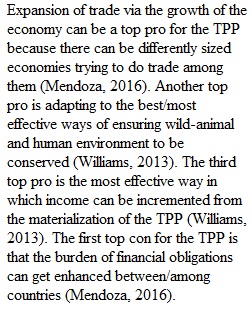


Q When preparing for your discussion post on this case, it is recommended that you read through it several times. • Read through it the first time to familiarize yourself with the prompt. • On the second reading, consider your assigned role in the situation, and let that guide your perspective. • Look deeper at the details: facts, problems, organizational goals, objectives, policies, strategies. • Next, consider the concepts, theories, tools and research you need to use to address the issues presented. • Then, complete any research, analysis, calculations, or graphing to support your decisions and make recommendations. International trade agreements are often written from a legal vantage point with language that may not be easily understood by all stakeholders. This might result in misinterpretations of the agreement by the various stakeholders and unexpected and/or unintended second- and third-order effects. For example, an international trade agreement may inadvertently put an industry at risk between one of the signatories. The Trans-Pacific Partnership (TPP) is a policy instrument which has personnel and organizations that support the agreement, but also groups that vehemently oppose it. You have just been elected to the U.S. Congress and appointed to sit on a committee to evaluate whether the U.S. should sign on to the Trans-Pacific Partnership (TPP). You are the junior member on the committee and have been tasked with developing a list of pros and cons for the TPP. A. After completing the reading and watching the video in this module, answer the following: 1. Provide the top three pros and three cons for the TPP. Explain why you feel each pro/con is significant enough to warrant discussion within the congressional committee. 2. Analyze the TPP using one of the trade theories explored in this module. You should specifically address whether the TPP would violate any of the theories key aspects. 3. Provide your recommendation and rationalization to the committee, on whether the U.S. should sign on to the TPP. Assume that the U.S. has not yet decided whether to join or not. B. When responding to at least two classmates, assume you are a member of the committee, and explain, using relevant theories and data, why their choice on whether the U.S. should join the TPP is or is not a wise decision. You must support your response to your peer with well-researched information (i.e. – not just opinion). Ensure you support your responses with scholarly reference material using APA formatting.
Q Ensure you support your responses with scholarly reference material using APA formatting. Consult the Discussion Posting Guide for information about writing your discussion posts. It is recommended that you write your post in a document first. Check your work and correct any spelling or grammatical errors. When you are ready to make your initial post, click "Reply." Then copy/paste the text into the message field, and click "Post Reply." To respond to a peer, click “Reply” beneath her or his post and continue as with an initial post. EVALUATION This discussion will be graded using the discussion board rubric. Please review this rubric, located on the Rubrics page within the Start Here module of the course, prior to beginning your work to ensure your participation meets the criteria in place for this discussion. All discussions combined are worth 32% of your final course grade.e.
View Related Questions